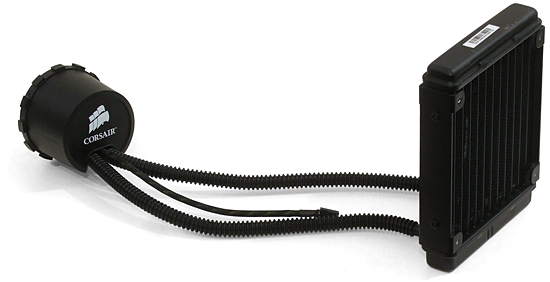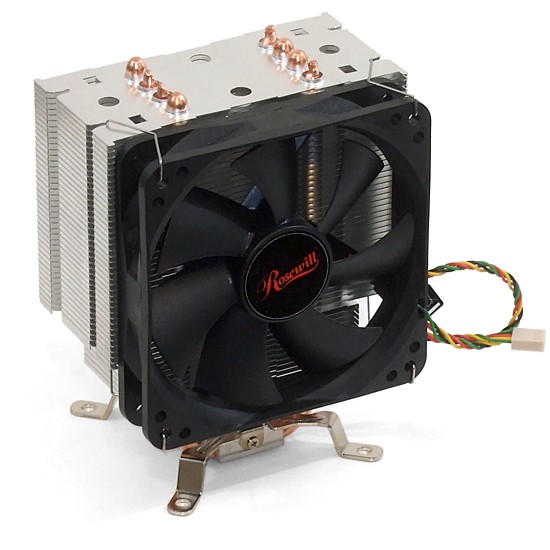Part 2: Little Water, Big Air--Corsair H50 Versus Rosewill FORT120
It's A Question Of Size
Do sealed liquid coolers provide a compelling performance alternative to air?
Liquid-cooling proponents cite the benefits of a larger radiator placed further from the heat source, saying it provides superior results. Meanwhile, fans of air-cooling criticize liquid coolers for their cost, complexity, maintenance, and potential for leakage. Yet, sealed liquid systems have almost none of the problems associated with larger do-it-yourself options. Their plastic cooling lines are nearly impermeable to evaporation, so there's no need to refill them, and they're impervious to the contaminants that so often clog serviceable component coolers. Corsair relied on maintenance-free cooling expert Asetek to develop its universal-fit H50.
Now, air-cooling aficionados point to the fact that the small radiators required to make a sealed liquid system “universal-fit” are already matched in surface area by several tower-style heatsinks. They also say that short, permanently-affixed coolant lines remove any possible benefit of alternative radiator placement. And while liquid-cooling guys can point to occasional installation woes for oversized air coolers, such as what we saw happen with our $1,300 System Builder Marathon build, air-cooling supporters feel such design disasters are avoidable, requiring just a little forethought when selecting parts for the configuration.
Going up against the H50, Rosewill sent its FORT120 for performance and fit testing. We included the results from our earlier comparison to evaluate any improvements these challengers may present. Will we find a new performance leader?
Get Tom's Hardware's best news and in-depth reviews, straight to your inbox.
-
Proximon Thank you. It's good to have more confirmation on a part. Redbeard from Corsair has been defending this unit on a thread over at that other site, perhaps he'll make an appearance here as well. As you say, it's a good part in some instances.Reply
I have to wonder though if performance would be different on Phenom IIs, where the motherboard is configured such that large air coolers don't work well. (AMD boards have a smaller space around the CPU.)
Also, I didn't see the TIM listed. Always like to know what paste is used. -
pendorchete How is the Corsairs H50 compared with the Asetek LCLC found in Falcon NW's Core i7 Mach 5 you've reviewed? What kind of temps produces in that system?Reply -
jongwoonkim Fan speed makes a huge difference in the performance of the cooler. I have similar cpu cooler. It wasn't doing what I needed but it had a bracket to add additional fan on the other side. I added a fan that did 2600rpm. The result was dramatic. Existing fan ran quietly at 1300rpm. Air delivered can change by factor of 2 between low rpm and high rpm. In order to give proper comparison H50 should have been test fitted with Rosewill's fan. I would think it will significant improve the performance. Over all exiting review and H50 seems to be an excellent engineering!!Reply -
haplo602 hmm I am waiting on a small LC solution like to corsair and domino with 80mm radiators to fit on the backplate of the aerocool M40. paired with 2 80mm fans, it should do wonders I guess.Reply -
amnotanoobie jongwoonkimIn order to give proper comparison H50 should have been test fitted with Rosewill's fan. I would think it will significant improve the performance. Over all exiting review and H50 seems to be an excellent engineering!!Reply
I also wanted to see what would happen with the H50 if it was retrofitted with the fan of the Fort120. If the H50 does outperform the Fort120, then I guess the H50 would really be a better overall solution.
-
coconutboy I'm curious why there's no dB chart for noise levels. Sure there's text, but we're not given solid numbers on each model. I'm a longtime THG reader from the '90s, but this type of data NEEDS to be in articles for people (myself included) who want a quiet system first, and a cool one second.Reply
Outside of that gripe, good review and in line with what I've seen elsewhere. Tough call on the Corsair since it's perhaps a wee bit pricey for what it does, but based on what I've read here and at anandtech etc, I'll likely buy it for the noise reduction and simple install. -
coconutboy Almost forgot to mention, I've read on a few other sites that users should be sure to check out the mounting hardware for the Corsair H50 before buying. IIRC, the screws that come with it can be problematic for some people's cases even if you have a 120mm fan mount. Example from the guru3d review-Reply
"So on top of the radiator a fan needs to be mounted. Pretty much you use these four screws (supplied) and push them through the chassis, fan and radiator. This mounting system is unfortunately far from ideal. Chassis' tend to differ, should the chassis be thick or have another mounting system design for the 120mm fan, these screws will not fit as there isn't any clearance.
Using your own screws should be done carefully as you can easily screw them in too deep and damage the radiator. We like these rubber push-pin retention clips we see a lot lately, perhaps something Corsair should look into for their next revision of the H50." -
mjello Will they make a gpu version too ? If not. Do you know about a similar solution but for gfx ?Reply
I suppose one could modify the system by adding a gpu waterblock to the loop.
However it might damage the system, and there is the question of reduced performance from the pump because of increased resistance from the extra hose and gpu block. And no warranty then heeh. -
Marcus52 H50 looks like something that may work with my Antec Skeleton rig, which needs a shorter CPU cooler. Still, the CPU temp performance is a bit underwhelming. I too wonder what the paste is, and if a better paste would help. More fan power looks like a good option too.Reply
I wouldn't try the H50 for a CPU and graphics card, it just doesn't have the cooling capacity to do both. Adapting it for a graphics board only might be an option, but you lose the pre-sealed system benefit, so not sure that's the way I'd go, even if it is cheaper.
Definitely a nice price on the H50!
;) -
nicklasd87 jongwoonkimFan speed makes a huge difference in the performance of the cooler. I have similar cpu cooler. It wasn't doing what I needed but it had a bracket to add additional fan on the other side. I added a fan that did 2600rpm. The result was dramatic. Existing fan ran quietly at 1300rpm. Air delivered can change by factor of 2 between low rpm and high rpm. In order to give proper comparison H50 should have been test fitted with Rosewill's fan. I would think it will significant improve the performance. Over all exiting review and H50 seems to be an excellent engineering!!Reply
I completely agree, I would consider buying that Corsair unit because of its obvious design advantages, and I have a 2600 rpm 120 mm fan I would like to hook up to it. I would really like to know how much of a performance advantage this would provide compared to the stock fan. If it outperforms the Rosewill with a faster fan, I would get the corsair in a heartbeat, I have been looking for a good cpu fan for a while now that would work well in my relitively small midsized lian li case, and water would work so much better than air at removing heat from the case.


